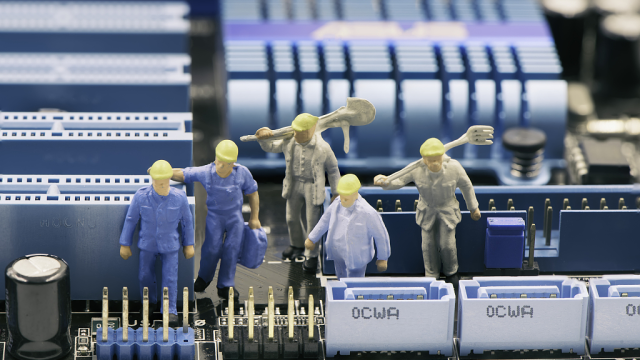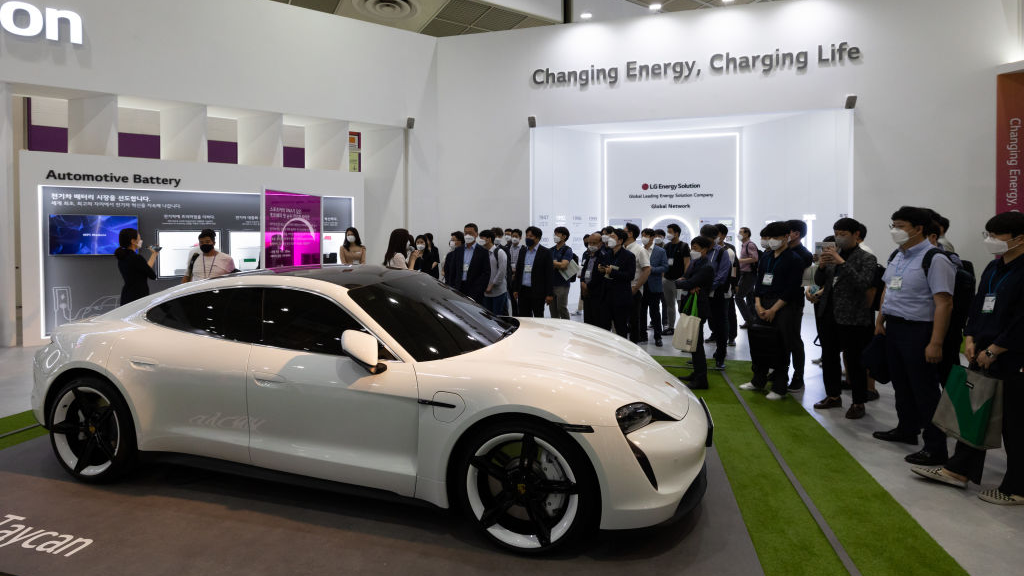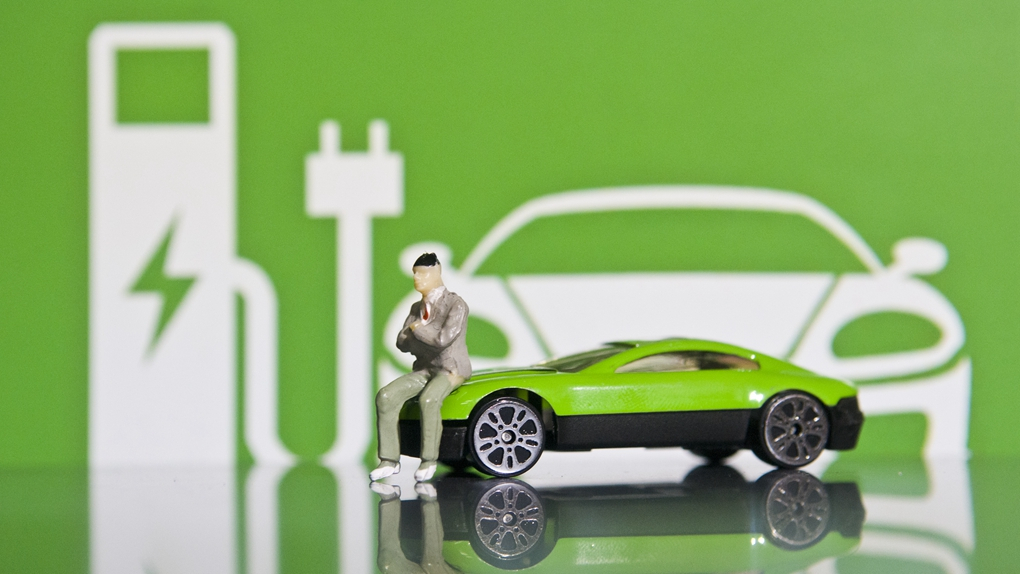2021-06-24
How the Battery Revolution Will Power Our Future
With the development of the industrial era, all industries need energy storage devices with higher energy density to promote the further development of the industry. Battery technology not only affects the development of industry, but also has a certain impact on the world energy structure.
Djoomart Otorbaev, a professor of the Belt and Road School of Beijing Normal University,and the former prime minister of the Kyrgyz Republic, has published a series of articles on China International Television (CGTN) recently, systematically discussing the battery revolution. The original text is as follows:
工业时代发展到现在,各行各业都需要一种更高能量密度的储能装置,来推进工业的进一步发展。电池技术不仅仅影响着工业的发展,更是对世界能源结构也产生着一定的影响。
北京师范大学一带一路学院教授、吉尔吉斯共和国前总理卓奥玛尔特·奥托尔巴耶夫(Djoomart Otorbaev)日前在中国国际电视台(CGTN)上发表系列文章,对电池革命进行了系统探讨。原文如下:
01
How the battery revolution will power our future

U.S. President Joe Biden has made batteries a critical component of his carbon-neutral strategy. He insists on American production of modern batteries rather than relying on imports from China. Chinese companies, including Contemporary Amperex Technology Co. Limited (CATL), BYD Auto, and Hefei Guoxuan High-Tech produce 79 percent of the world's batteries. American manufacturers make only seven percent.
According to innovator Elon Musk, batteries are the key to our future. Their development led to the technical revolution that brought smartphones, tablets, and electric vehicles to the world. Therefore, it is surprising that the science behind the lithium-ion batteries driving the modern world has remained essentially unchanged for more than three decades.
The prototypes of lithium-ion batteries appeared in the 1980s. Then the physicist John Goodenough suggested using lithium cobaltite in batteries. In 2019, he received the Nobel Prize for his idea.
A BloombergNEF study found that the average price of lithium-ion batteries fell from $688 to $137 per kilowatt-hour between 2013 and 2020. They predict that by 2023 prices will be close to $100 per kWh. The average price of batteries for electric vehicles (EV) was $126 per kWh. Thus, the cost of the battery pack in the total vehicle price dropped to 21 percent. By 2030, due to new technological advances, the cost of batteries can drop to $58 per kWh.
However, lithium-ion batteries have serious disadvantages. Among them are a high fire hazard, sensitivity to temperature differences, self-discharge, and aging. Many still remember the story of the Samsung Galaxy Note 7 series smartphones that suddenly caught fire. It is this property that prompted airlines to require the carriage of lithium-ion batteries exclusively in carry-on baggage. Another liability is that lithium-ion batteries used in electric vehicles contain hundreds of kilograms of metals and materials such as graphite, cobalt, and high-purity nickel. When mined and processed, it can cause significant pollution and increase carbon dioxide emissions.

For example, an average battery of a light EV requires about 20 kg of nickel and up to 20 kg of cobalt in the cathode. Of the metals used, nickel is critical as it helps the batteries store more energy and reduces the need for the more expensive cobalt. Tesla accounted for more than half of all nickel used in the European electric vehicle industry last year, and Musk selects its supply as a concern. Tesla plans to produce three terawatt-hour batteries by 2030, which will deplete most of the world's nickel production at current levels.
According to Fastmarkets, cobalt prices, as the world's most expensive metal, rose to $42 per kg in March 2021. Analysts predict that by the end of 2021, they will reach $57, and in 2024 they will reach $80. The primary deposits of cobalt are located in the Democratic Republic of the Congo.
Therefore, it is not surprising that companies are actively developing new types of batteries. For example, General Motors (GM) has partnered with SolidEnergy Systems to manufacture Ultium batteries for its electric vehicles. These will include a liquid electrolyte, graphite-based anodes, and cathodes with a mix of nickel, cobalt, manganese, and aluminum. As a result, the price of batteries will drop by 50-60 percent, and their weight will decrease. As a result, GM expects to reduce the cost of storing 1 kWh of electricity from $150 to $100 by 2025.
More and more electric vehicles in China use alternative lithium iron phosphate (LFP) batteries. They are cheaper and less toxic but have a lower capacity. Such batteries are developed by Tesla Model 3, the Chinese automaker BYD, and Volkswagen. But so far, LFP batteries account for only 14 percent of the market, and by 2030 this figure will be from 15 to 20 percent.
Tesla and Volkswagen are also promising to cut cobalt use in the coming years. Last year Elon Musk held a special online presentation called Tesla Battery Day. He announced that Tesla would begin mass production of a new generation of batteries that will be much more powerful and durable than the current ones within three years and cost half the $25,000. Tesla's new 4680 battery pack will be six times more potent than its predecessors and five times more energy-efficient. Moreover, its size will be only 46x80 mm.
Lithium-ion batteries' severe flaws and shortcomings make it understandable for the excitation around radically new ways to develop solid-state batteries. The technology will use solid electrodes and a solid electrolyte instead of the liquid or polymer gel electrolytes found in lithium-ion batteries. Radically new technology promises to address many of these environmental and safety concerns.
In addition, this innovative generation power supply will store energy at a much higher density. Electrolytes also serve as a battery separator, a vital component of a lithium-ion battery, reducing the risk of fire and the number of raw materials needed.
The pursuit of shorter charging times and longer mileage without increasing the cost of battery packs and the risk of fire are the most striking improvement trends in modern batteries. Removing these limitations is key to making the battery revolution genuinely irreversible.
How will battery revolution power our future? Promising applications

Two main reasons are driving the current trend for massive investments in the battery industry: the explosive demand for electric vehicles (EVs) and the dramatic rise in the cost of industrial metals. Thanks to strict emission standards set by regulators to bring new cars to market, global EV sales have more than doubled over the past year. In addition, an increasing number of countries, such as Germany, the UK, the Netherlands, Denmark, Ireland and India, have confirmed banning gasoline and diesel vehicles from 2030.
A record 1.3 million electric vehicles were sold in China in 2020, representing 41 percent of global EV sales, just behind Europe with 42 percent. The U.S. was far behind with just 2.4 percent. Analyst firm Canalys predicts that 1.9 million EVs will be sold in China in 2021, up by 51 percent from the year earlier, and the EV's share of all cars sold in China will reach an impressive 9 percent. "We are no longer talking about subsidies; they now represent a small fraction of the total cost of a car, only about a tenth," says Mark Mao, an analyst at JPMorgan Asset Management.
This optimism is further reinforced by the fact that battery manufacturers are cutting production costs. For the traditional lithium-ion battery – the most expensive component in an electric vehicle – cell prices have dropped by nearly 90 percent over the past decade to about $110 per kilowatt per hour (kWh) last year, according to Benchmark Mineral Intelligence consultancy.
Today, on average, EVs are 45 percent more expensive than conventional gasoline-powered vehicles. But this gap is constantly closing. According to analysts at UBS, there are only three years left before price parity is reached. After that, the demand for EVs will increase even more, which automatically means an increase in the need for batteries.
It is solid-state batteries that will replace lithium-ion counterparts soon. Solid-state batteries will be safer, cheaper and last longer without sacrificing performance, requiring fewer raw materials. They are lighter, fully charge in about 10 minutes, and have a higher energy density to provide double or more range. Much less copper and aluminum will be needed. In addition, it is possible to exclude graphite and cobalt from the production process. Finally, disposing of solid-state batteries is much easier and safer.

On average, solid-state batteries will be able to store 80 percent more energy than lithium-ion ones of the same weight and volume. The energy density of conventional batteries has increased annually by 4 percent over the past two decades to 0.7 kWh per liter (kWh/L). It corresponds to a range of about 500 kilometers for a passenger car. But further expansion was challenging to achieve due to the volume occupied by the cells and liquid electrolytes.
Solid-state batteries offer step-change. Not only will they increase the energy density of the battery cells to 1 kWh/L – for a driving range of 800 km – but they can also withstand more charge cycles before degradation begins. They will also store more energy over a much longer lifespan, allowing the usage of just one battery for 1 million miles.
Silicon Valley startup QuantumScape, backed by Volkswagen and Bill Gates, is currently attracting the most attention. The company aims to commercialize batteries as early as 2024. Since its listing last year, its shares have gone up by more than 1,000 percent, and at one stage, it had a market capitalization of nearly $50 billion, more than GM's value.
An analysis of the number of acquired patents makes it possible to understand how close the manufacturers are to commercialization. Since 2005, according to the European Patent Office, the number of new patent applications for batteries and energy storage equipment has grown four times faster than the average for all other technology areas. The highest growth rates were achieved in solid-state batteries, indicating a faster-than-expected time to market.
Nine of the top 10 patent holders are Asian companies. Seven of them, led by Panasonic and Toyota, are based in Japan, with Samsung and LG in South Korea. The only representative of another region was the German concern Bosch, which ranks at fifth place.
Companies that currently dominate the traditional sectors of battery, vehicle and accessory manufacturing and have access to materials sourcing are at substantially better starting positions for mass production of batteries.
For these reasons, several Asian companies appear to be in the best position to win the solid-state battery competition. This year, Toyota will unveil a prototype battery that takes only 10 minutes to charge and will last for 500 km. Their Lexus LF-30 compact solid-state battery concept model has introduced two years ago and now holds 1,000 patents for solid-state battery technology. Solid-state batteries deteriorate much less over time, and Toyota aims to achieve 90 percent of the battery's performance over a 30-year lifetime.
A similar development from Samsung may offer a battery capable of supporting up to 800 km on a single charge. Moreover, their life cycle of more than 1,000 charges is qualitatively different from existing batteries, which lose capacity after 60 charges. In no time, we will see revolutionary changes in the development of advanced batteries that will change our world forever.
How will the battery revolution power our future? China will move fast

After many years of planning and hard work, China now dominates the global production of the newest batteries, which are crucial to carbon footprint and sustainable development. The main applications for the new batteries are in electric vehicles (EVs) and portable consumer electronics such as cell phones and laptops. For example, battery cells and assemblies account for 35 to 50 percent of the cost of electric vehicles.
According to BloombergNEF intelligence, China's current success is the result of several fundamental factors. China has large domestic battery demands. The country controls 77 percent of the world's battery capacity, 80 percent of raw materials refining, and 60 percent of global component manufacturing. For this parameter in 2020, Japan, South Korea, and the U.S. ranked second, third, and sixth.
Many experts agree that the main reason for the current dominance of China in the production of the latest batteries is the government's policy. It actively spurred the rapid growth of hundreds of local startups by providing them with cheap loans and tax incentives. One of the brightest examples of such companies is the history of the CATL startup. Founded in 2011 as the cell phone battery division of TDK, which has supplied products to Apple and other mobile device manufacturers, it has impressively grown since then.
Critically, CATL used the government-backed Thousand Talents plan to recruit top-notch experts from around the world. Among them was the company's current Chief Technology Officer, Bob Galyen, an internationally renowned American battery technology expert. Engineers also came from such companies Bosch, Continental, and Valeo.
CATL has now become the world's largest manufacturer of batteries for electric vehicles. For the past four years, South Korean market tracker SNE Research has ranked it number 1 in electric vehicle batteries with a market share of 27.9 percent.
A month ago, CATL founder Zeng Yujun told Bloomberg that the company had developed a power system that can run over a million miles. Their main customers include Tesla, Daimler AG, BMW, and Toyota.
The U.S. is especially concerned about lagging behind China in battery production. Simon Moores of Benchmark Mineral Intelligence, speaking before a committee of the U.S. Congress in May of last year, said: 'We are in the midst of a global battery arms race, in which so far the U.S. is a bystander… Yet China has consolidated its power over their production and processing while America lags far behind." At a congressional committee meeting, it was stated that there are 136 large factories to produce batteries for electric vehicles in the world today. Of these, 101 in China and only eight in the U.S. China launches a new gigafactory of batteries every week, the U.S. one in four months.
At the China Auto Chongqing Summit held on June 12 and 13, two leaders of China's largest electric vehicle manufacturers announced that electric cars and plug-in hybrids would dominate the world's largest auto market in about a decade. This category accounted for more than 10 percent of new car sales in China in March and rose to 11.5 percent in May, said Wang Chuanfu, founder of BYD. He predicts that penetration will increase to over 70 percent in 2030. William Lee, founder and CEO of electric car startup Nio was even more optimistic. He predicted that so-called intelligent electric vehicles would account for 90 percent of new car sales in 2030.
Crucially, Chinese officials and car company executives call for stable policies in the post-subsidy era to ensure the growth of the intelligent EV sector in the world's largest auto market. China began offering subsidies for new energy vehicles in 2009, but the government is phasing out the incentive and plans to end it altogether starting in 2023.
Fu Bingfeng, executive vice president of the China Association of Automobile Manufacturers, said China's new energy vehicle market would grow 40 percent year on year for at least the next five years. He estimates that such cars will account for 20 percent of new vehicle sales in 2025. That figure was 8.7 percent in the first five months of this year and 5.4 percent last year. Beijing would like to see 20 percent of cars sold on new energy by 2025. According to the McKinsey Electrification Model, it has been estimated that China will remain the leader in electric vehicle sales with 9.0 million units sold in 2030, compared with about 5.5 million in Europe.
The critical point for the future development of vehicles is that they must be environmentally friendly and intelligent. Future cars will become mobile cabins in which passengers can comfortably work or rest. Only those who excel in software, artificial intelligence, and smart manufacturing can become leading players in the future of the automotive industry. The future will be not necessarily car companies but those that can improve the latest vehicles, acting as efficient ecosystems based on innovative low-carbon technologies.




